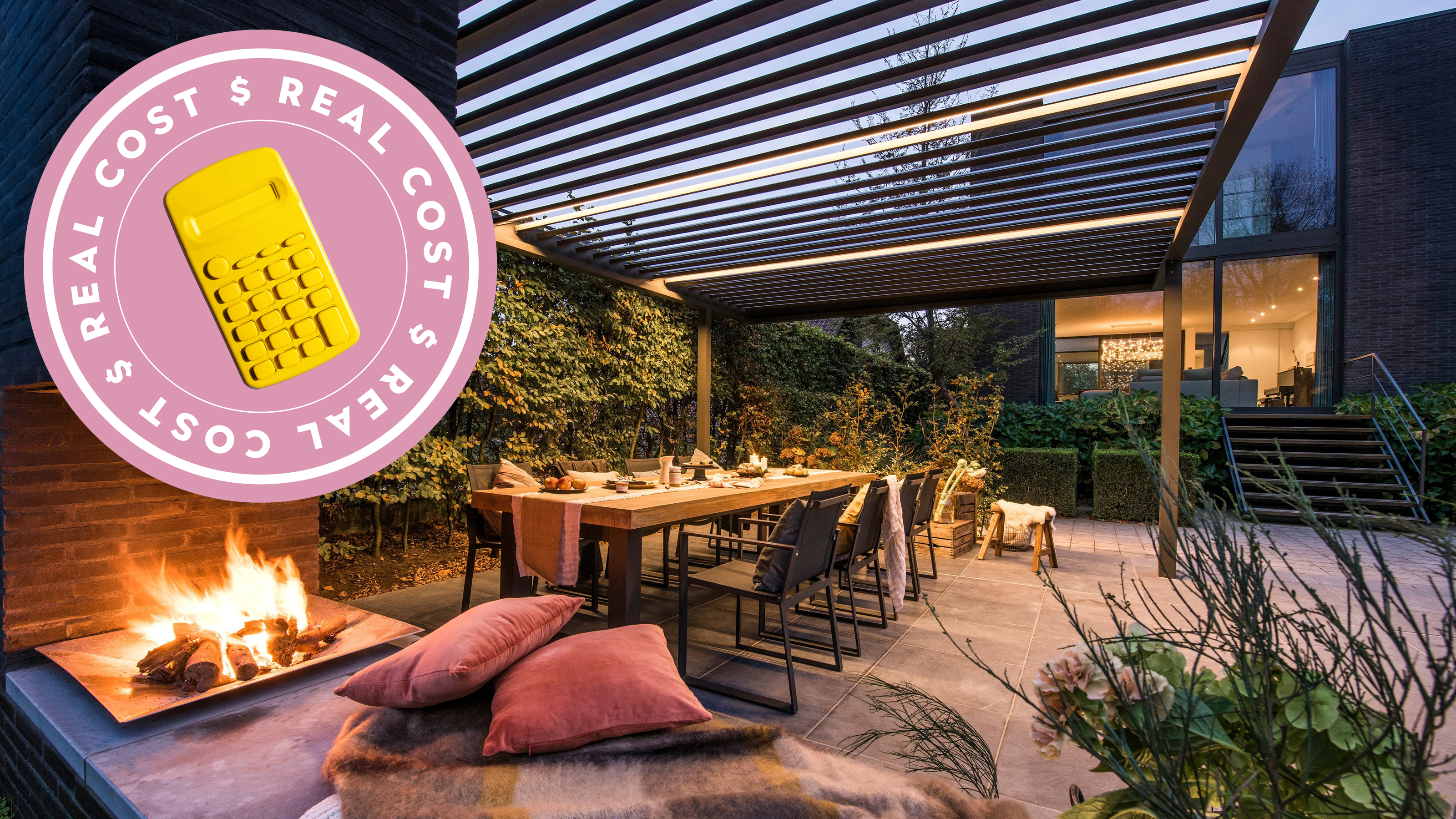How much does it cost to cover a patio?
If the sun and rain keep you from enjoying your yard, get clued up on how much it costs to cover a patio. Whether you choose a temporary shade sail or a permanent roof-over, it will mean you enjoy outdoor living to its fullest.


A backyard patio is the perfect location for entertaining friends, enjoying a cookout, or basking in the sun. But during the hottest part of the summer, the sun is not your friend. But consider budgeting for the cost to cover a patio to enjoy this space all year round – rain or shine.
Covered patios look great all while keeping you cool in the summer, providing shade, protecting your patio furniture, and making outdoor living more enjoyable. Covering your patio protects the inside of your home, too. Less sun shining in the windows means your home stays cooler, your furnishings won’t fade, and you enjoy lower energy costs.
Why cover a patio?
Patio cover ideas come in multiple styles–from an easy-to-install umbrella to a professionally built permanent structure like a pergola. Before committing to one solution, though, let’s look at the different reasons to cover your patio, the factors that influence your style choice, and the pros, cons, and costs of different types of covers.
There are many benefits to covering your backyard patio. In addition to those already mentioned, here are a few more to consider:
Factors that go into choosing a type of patio cover
'When choosing a patio cover, you should consider the type of cover you want, the size of your patio, and your budget,' says Bailey Carson, home care expert at Angi. Also, knowing whether you want something permanent and connected to your home or something removable helps you choose the right style for your outdoor living space.
'Before you can start shopping, you need to decide how much area you want to cover,' says Carson. Then, you’re able to choose which type of cover you need. For example, a permanent roof might be the best option for covering the entire patio, but a large awning may fit better in your budget.
Next, set a realistic budget. Temporary covers like shade sails and umbrellas are more affordable than awnings. But permanent patio covers give you a better return on your investment and improve the value of your home, according to national home improvement expert Danny Lipford, host of the nationally-syndicated TV and radio program Today’s Homeowner with Danny Lipford.
Get small space home decor ideas, celeb inspiration, DIY tips and more, straight to your inbox!
'A patio cover should look original to the home to get as much value as you can,' Lipford says. 'Matching roofing materials and style will get you the best ROI.' If your budget will support a permanent roof over, he suggests doing it. 'I’ve seen patio covers done properly–to look like they were part of the original construction–evolve over time. Now, you have an open-air patio, then you screen it in, next, you have a sunroom, and eventually a living space.'
The average cost of different types of patio covers
Temporary patio cover costs
Temporary patio covers include awnings, shade sails, and umbrellas. They are the best option for renters or homeowners who don’t want permanent construction. Temporary covers are also attractive to those on a low budget who want more use from their space while saving for something more permanent. Here are a few temporary options, their average cost, and the pros and cons of each.
Retractable awning–A retractable awning attaches to the home over a window or door to provide shade outside and inside. Whether manually operated or motorized, retractable awnings come in various standard sizes or are custom-made. Manually-operated awnings cost about $500, according to Carson. But, motorized awnings can cost $3,500 and up. Larger awnings with more features command a higher price tag. When shopping, look for features like waterproof fabric, phone app controls, weather sensors, and integrated lighting and heating.
Pros:
- Many options to choose from
- When you want sunshine, you retract the awning
- Fits a wide range of budgets
Cons:
- Most expensive temporary cover
Shade sail–A shade sail is a triangular- or rectangular-shaped canvas attached to the structure at its points. Shade sails come in many sizes and colors, priced from $20-$200, depending on size and material. Make sure your patio has a point of contact for each corner of the sail. If not, erect a post or two for this purpose. Also, look for features like reinforced grommets, waterproof and UV-protected fabric, and included hardware.
Pros:
- Easy to install
- Removeable for wanted sun exposure
- Comes in a wide range of colors and sizes
Cons:
- Cannot withstand some storm winds
- May need to provide extra support columns
Umbrella–Consider an umbrella when you want to shade a small area. Umbrellas are an affordable solution for a temporary cover over a dining table or seating area. According to Carson, a typical table umbrella can cost about $50 but for a large side mount, pivoting one expect to pay around $900. When choosing an umbrella, don’t forget to purchase a base to hold it in place. Wayfair has a good selection of patio umbrella bases and stands. Also, remember you’ll need room to store it during the winter months. Finally, look for features like solar-powered lighting, motorized operation, and UV-protected fabric.
Pros:
- Easy to install and remove
- Only shades a small area
Cons:
- Must have a heavy base that’s difficult to move and takes up floor space
- Cannot withstand winds
Permanent cover costs
For most permanent patio covers, you’ll need to hire a reputable contractor to do the construction and possibly an architect to create the plans. Or, you can order a DIY sheet metal kit to erect yourself. However, according to Lipford, 'tacking a flat metal roof on the house is like throwing money into the wind.' In addition, he said they’re hot in southern climates and won’t hold the snow load in the northern parts of the country. Here are a few types of permanent covers, their average cost, and the pros and cons of each.
Pergola–A pergola with vertical pillars that support a series of cross-beams set on their edge to form a lattice. While it does provide a bit of shade, some homeowners use it to support vining plants to improve the shade and add a natural environment. Pergolas can be built to any size and can be freestanding on a large patio to define a seating or dining area or attached to the home to shade the entire patio. You can build a pergola out of wood or vinyl. According to the home services website Fixr, the average cost to build a pergola in the U.S. is $1,900-6,500, with some costing as low as $1,000.
Pros:
- Less expensive than other permanent options
- Can be built any size
- Can be freestanding or attached to the home
- Offers support for vining plants
- A DIY-friendly option
Cons:
- Offers some shade but no rain protection
- More ornamental than protection from the elements
Gazebo–A gazebo is a hexagonal or octagonal-shaped roofed structure with open sides. They’re typically freestanding rather than attached to the home. When erected over a patio, a gazebo offers a separate area for dining or entertaining while providing sun and rain protection. To give a bit of privacy or extra coverage from wind and rain, enclose the sides with lattice or hang curtains. Because of the roof structure, gazebos are more costly than a pergola. According to Fixr, the average homeowner pays between $7,500 and $10,000 for a gazebo, with some costing as low as $4,000.
Pros:
- Offers more protection from sun and rain than a pergola
- Can construct of a variety of materials
- Can wire for lighting and sound
- Adds value to the home
Cons:
- Not DIY-friendly
- More costly than a pergola
- Round shape harder to work with
Enclosed roof–When built to match the home, the enclosed roof gives you the greatest return on investment and adds the most value. It’s also the best choice for longevity. According to Fixr, the average homeowner pays between $2,200 and $18,900 for a gabled roof patio cover. Tying the patio covering into the house roof adds to the cost.
Pros:
- Gives the highest return on investment
- Best choice for increasing home value
- Can be built to match the style of the home
- Provides the start for a future enclosure
Cons:
- Most expense option
- Not a DIY job
More considerations
According to Lipford, any permanent cover tied into the home requires a building permit, which adds a few hundred dollars to the total cost, depending on where you live. Also, irregularly-shaped patios deserve a cover just as much as rectangular ones. Just because your patio is kidney-shaped or has curves doesn’t mean the cover has to be the same. 'It’s not taboo for the roof to not be the same shape as the slab,' says Lipford. That extra patio that forms the curves is the perfect place for planters.
So, don’t wait to protect your patio, family, and friends from the elements. Instead, add a cover to extend your outdoor living season this year.
Carol J. Alexander writes website copy, blog posts, and feature articles on home remodeling and construction topics from her home in the Shenandoah Valley of Virginia. In addition to Real Homes, notable clients include, This Old House, Family Handyman, and Florida Roofing magazine.
